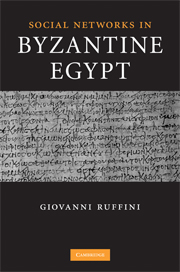Book contents
- Frontmatter
- Contents
- Dedication
- List of figures
- List of tables
- Acknowledgements
- References and abbreviations
- Introduction
- Chapter 1 The centralized elite of Oxyrhynchos
- Chapter 2 The growth of the Apions
- Chapter 3 Aphrodito and the strong ties of village society
- Chapter 4 Quantifying Aphrodito's social network
- Conclusion
- Stemmata
- Bibliography
- Subject index
- Index locorum
Conclusion
Published online by Cambridge University Press: 26 June 2009
- Frontmatter
- Contents
- Dedication
- List of figures
- List of tables
- Acknowledgements
- References and abbreviations
- Introduction
- Chapter 1 The centralized elite of Oxyrhynchos
- Chapter 2 The growth of the Apions
- Chapter 3 Aphrodito and the strong ties of village society
- Chapter 4 Quantifying Aphrodito's social network
- Conclusion
- Stemmata
- Bibliography
- Subject index
- Index locorum
Summary
From the start, I have stressed that both traditional prosopography and network analysis create divergent social pictures of Oxyrhynchos and Aphrodito. Aphrodito village society had a powerful face-to-face element, in which social ties developed along pre-existing lines. Analysis of the strongest ties in the Girgis prosopography highlighted the importance of corporate links – particularly among the community of landholders and the community of shepherds – and did not uncover particularly strong links of a subordinating nature, such as patron–client. Analysis of Aphrodito's petition to the empress Theodora strengthened this impression. The Aphrodito villagers presented themselves by group, naturally taking social action with those to whom they already had corporate ties. Contrary to what Gagos and van Minnen have argued, an unprejudiced reading of the sequence of names in that petition suggests a relatively relaxed approach to whatever social hierarchies existed.
The structural characteristics of the Aphrodito network as a whole support this impression. An average distance through the entire network of under three degrees of separation suggests that Aphrodito's social world was relatively small. We must also remember that distance only measures ties attested in the documentary record. It is for that reason impressive that Aphrodito should appear so small on paper. Certainly, in any village society, most people would be familiar to one another by sight or by reputation. By this measure, Aphrodito's world would have been even smaller than the documentary evidence suggests.
- Type
- Chapter
- Information
- Social Networks in Byzantine Egypt , pp. 242 - 254Publisher: Cambridge University PressPrint publication year: 2008



